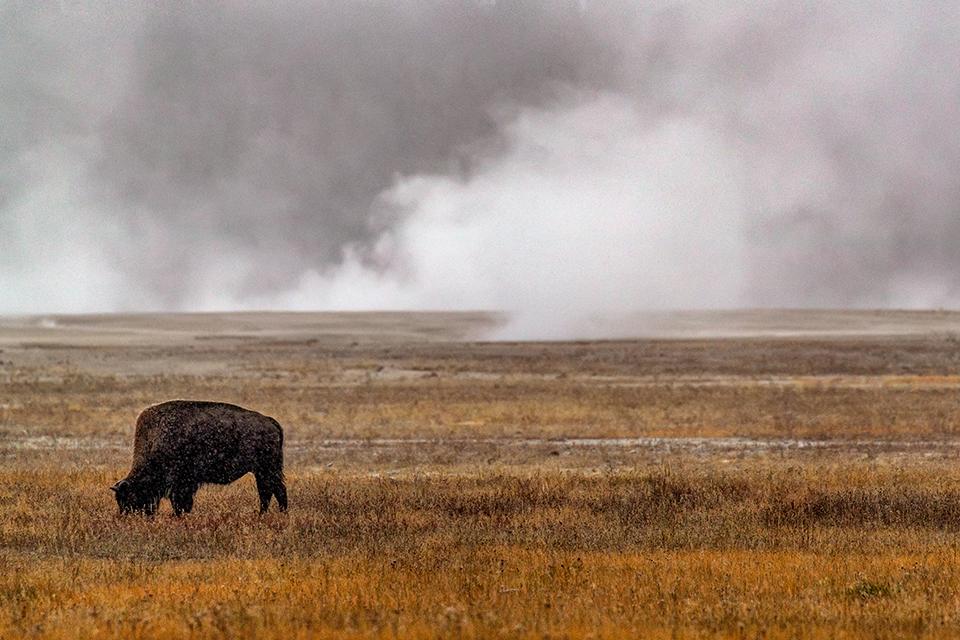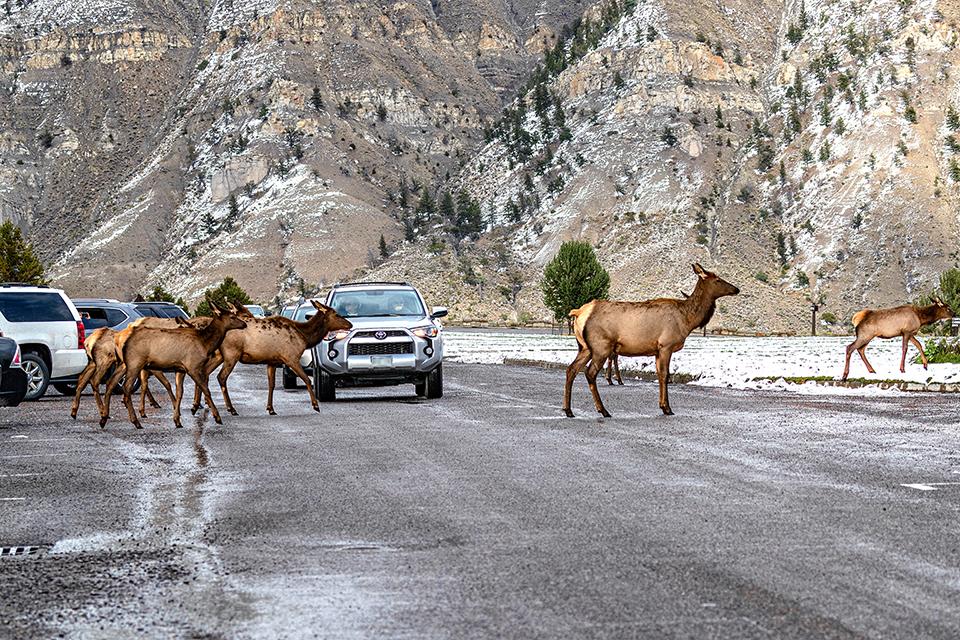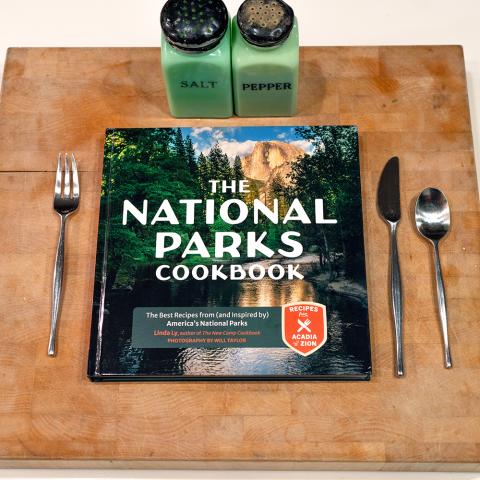
Grazing in an autumn snow storm, Yellowstone National Park / Rebecca Latson
Yellowstone National Park has so many distinctions, I don’t know where to begin. America’s first national park – heck, the world’s first national park – is a geologic heaven and a photographer’s paradise. This national park is often referred to as the “American Serengeti” for its (relatively) easy-to-view populations of wolves, bears, elk, deer, bison, pronghorn, and many more mammal, bird, reptile, and amphibian species. Putting together a Traveler’s Checklist was a little daunting as there is so much to do, see, and learn in Yellowstone. I might have left something out, but if you are planning a trip to this Wyoming (and Montana and Idaho) wonderland, then hopefully this checklist will help you make the most of your explorations.

Map of Yellowstone National Park / National Park Service
Yellowstone is a large park for the Lower 48 (approx. 3,472 square miles / 8,991 square kilometers). There are five entrances with hours of drive time between each one. Five percent of the park is covered by water, 15 percent by grassland, and 80 percent by forests. More than half the world’s active geysers reside within park confines, along with over 10,000 hydrothermal features.
Most people either drive or fly to Yellowstone. Commercial airlines fly into Bozeman and Billings in Montana, Cody and Jackson Hole in Wyoming, and Idaho Falls in Idaho. From Salt Lake City, you can fly into the West Yellowstone, Montana, airport from early May to mid-October.
- As you pack your t-shirts and shorts, don’t forget to throw in a jacket or sweater. Mornings and evenings are chilly in the high elevations, and there’s always a chance of rain anytime in the park, as well as snow in autumn and spring. Naturally, you should expect (and pack for) snow in the winter. Remember to throw in a pair of sturdy hiking boots too. Sure, sandals and sneakers work for the paved areas and boardwalks, but if you choose to strike out on any of the more than 900 miles of hiking trails, you’ll definitely want something to protect your ankles and keep you from stumbling over uneven dirt-and-rock pathways.
- Pack bear spray and carry it with you on all your outdoor outings. Airlines don’t allow it in either carry-on or checked luggage, but upon your arrival, you can buy or rent bear spray in surrounding communities like West Yellowstone, Gardiner, Cody, Jackson Hole, and Bozeman.
- Luckily for you, there’s quite a variety of lodging choices within and around this park. The caveat is that reservations often must be made up to a year ahead of time if you want to stay at any of the in-park brick-and-mortar lodges. Airbnb, Vrbo, and hotels/motels/cabins within communities around the park offer a range of rooming choices, as well, often at lower rates versus the in-park choices.
- There are 12 campgrounds from which to choose in Yellowstone. The Yellowstone National Park Lodges site takes reservations for five campgrounds, and reservations for three of the seven campgrounds managed by the National Park Service can be made via recreation.gov this 2021.
- If you are thinking of heading out and getting away from it all for some backcountry camping, you’ll need a permit and a plan. This handy 7-page PDF backcountry trip planner offered by the park will help with the planning part.
- Depending upon the time of year you visit Yellowstone, you might be inundated with crowds. Prepare yourself for HUGE crowds during the summer. Come with a healthy dose of patience and a Plan B. I visited for a couple of summer days during my road trip move from Texas to Washington state. I found that if I left at the crack of dawn to get to a planned spot, I stood a pretty good chance of finding parking. Of course, I then needed to spend most of the rest of the day in that area, because parking spots were full by about 8 a.m.
My autumn visit still saw crowds in places, but certainly less than during the summer, and with the exception of the extremely popular Midway Basin, I had no problems parking anywhere else. I did, however, experience cold autumn days of ice and snow, but thankfully had remembered to pack traction devices for my boots.
Roads begin opening to vehicles during early spring (April), and by Memorial Day, they are all accessible. You’ll be able to hike the lower elevations, but you might still wish to pack your snowshoes or cross-country skis for higher-elevation forays. Bring your binoculars, spotting scopes and/or telephoto lenses, because wildlife will be making a grand entrance and you might get lucky enough to see spring babies. Follow the rules regarding viewing and photographing wildlife, which includes NO FEEDING the wildlife. Keep yourself and the animals safe, and let wildlife be wild.
Winter in Yellowstone opens up a whole new world to the park visitor, with “trees draped in rime ice, steaming rivers and hot springs, and foxes making acrobatic leaps as they chase rodents under the snow.” Bring your snowshoes, cross-country skis, and a suitcase filled with warm clothing. There are definitely fewer crowds, but the temperatures can get into the negative numbers (-20 is pretty darned nippy) and almost all park roads are closed to traffic as are most other services. Popular destinations may be reached by snowcoach or snowmobiles.
- In January 2020, the Traveler published an article about the amount of time Americans spend within the parks. Sure, you can spend a couple of days in Yellowstone and see many, if not most, of the main sights (Grand Prismatic, Old Faithful, Fountain Paint Pots, Norris and Porcelain Basins, Hayden and Lamar valleys, Mammoth Terraces, etc.) but you’ll be doing quite a bit of driving, won’t be able to stay at any one place for very long, and ultimately do yourself a disservice for not getting more of a feel for the park. If you stay several days in the park, then my advice is to visit one or two areas of the park each day so you have plenty of time to digest all the park’s wonders while walking around. Look at a park map and discover just how many areas there are to explore: the Old Faithful area (which includes Black Sand Basin, Biscuit Basin, and Midway Geyser Basin), Canyon Village and the Grand Canyon of the Yellowstone (which includes Upper and Lower Yellowstone Falls and Dunraven Pass), Norris Geyser Basin, Fishing Bridge, Lake, and Bridge Bay (which includes Yellowstone Lake, Mud Volcano, and Hayden Valley), Madison and the West (which includes Firehole Canyon Drive and Firehole Lake Drive), Mammoth Hot Springs and the North, Tower-Roosevelt and the Northeast (which includes Lamar Valley and Tower Fall), West Thumb, Grant, and the South (which includes West Thumb Geyser Basin).
- Speaking of walking around, there are all sorts of hiking trails within the park, long and short, quite a few of them wheelchair accessible. Here are a few suggestions for those of you with limited time or who cannot, or don’t really want to, hike much on a long trail. Walk as many of the boardwalks and paved trails as possible – these include the boardwalks at all the geyser basins, as well as Mammoth Hot Springs, and various paved walkways along Yellowstone Falls and at view areas like Calcite Springs (located on the road to or from Tower Fall). These easy walks are wonderful introductions to the colorful and steamy world of geysers and hot springs. Just imagine: beneath the fragile crust exists some of Earth’s extensive heated plumbing. This is why you should always obey the signs and stay on the trail. During my autumn visit, a man decided to take a midnight stroll off the boardwalk and onto Old Faithful. He suffered some pretty bad burns.

A telephoto view of Grand Prismatic from the Grand Prismatic Overlook, Yellowstone National Park / Rebecca Latson
- For a short hike, walk to the Grand Prismatic Overlook in the Midway Geyser Basin for an above-ground view of this stunning, colorful hot spring. The 1.2-mile there-and-back trail begins at the Fairy Falls Trailhead and forks to the left for a 105-foot climb to a rather small view area (bring your patience and wait your turn for a photo).
- After capturing selfies at the Grand Prismatic Overlook, continue your Fairy Falls hike for a longer, approximately 5-mile there-and-back, stretch of the legs. There are actually two different trailheads to reach this waterfall: the trail from the Fairy Falls parking area, or the trail at the end of Fountain Flat Drive.

A view of Old Faithful from Observation Point, Yellowstone National Park / Rebecca Latson
- For a great overhead view of Old Faithful, the Old Faithful Inn, and the tiny, ant-like people wandering the boardwalks there, hike the 1.6-mile there-and-back Observation Point Trail. If you time your hike just right, you’ll arrive at the view point to see Old Faithful erupt.
- Hike the 3.5-mile “lollipop loop” Elephant Back Mountain Trail through a lodgpole forest to an overlook with a wide-open Yellowstone Lake view.
- If you don’t feel like hiking or driving, how about getting some exercise riding your bike or ebike, both of which are permitted “on established public roads, parking areas, and designated routes.” It’s a good idea to wear a bike helmet and high-visibility clothing for your safety. Remember to obey traffic rules of the road while you are cycling.
- Five percent of the park is covered by water, so bring your boat, kayak, or canoe, or just your rod and reel to go boating and/or fishing on some of that water. Know before you go and click on the links to read regulations, what kind of permits are required, where you can boat and what fish you can catch. In addition to a permit, boaters also need a Yellowstone aquatic invasive species inspection.
- Feel like exploring the wilderness on horseback? Yellowstone offers a few different options for horseback riding. Private stock users must obtain a free day ride permit. If you don’t feel like handling it all yourself, then go with a guided trip. There are a number of private, licensed outfitters authorized to operate within the park, and Yellowstone National Park Lodges offers some wild west adventures including horseback rides, stagecoach adventures and an Old West dinner cookout. Yee hawww!
- Join a ranger-led program. Yellowstone has all sorts of talks, tours, and Junior Ranger activities. Check the park’s website and visitor centers to see what is available.

Gibbon Falls, Yellowstone National Park / Rebecca Latson
- Go waterfall watching. Yellowstone is home to nearly 300 waterfalls of all sizes, including Fairy Falls, Gibbon Falls, Upper and Lower Yellowstone Falls, Kepler Cascades, Firehole Falls, and Tower Fall. Some are reached via hiking trail, and others may be seen from a view area complete with parking just off the road. Take your camera with you and practice your silky water technique.

Castle Geyser and the Milky Way, Yellowstone National Park / NPS-Neal Herbert
- Stay up late for stargazing and night photography. Time your walk along a boardwalk in Upper Geyser Basin to view (and photograph) a geyser eruption against a backdrop of twinkling stars and the Milky Way. For tips on photographing the night sky, click here.
- Speaking of photography, this park is a landscape and wildlife photographer’s dream. As the park’s website states: “People travel from around the world to take pictures in Yellowstone.” If you are planning a photo trip, then here are a few tips.
- Park in pullouts and other legal parking areas.
- Stay on the boardwalks and trails.
- Carry bear spray.
- Carry rain/snow protection for your camera. Go to a site like BHphotovideo.com or Adorama.com and type “camera rain protection” in their search engines to pull up different brands and price ranges for camera weather protection.
- Bring extra batteries (and your battery charger).
- Bring plenty of memory cards so you don’t have to worry about which photos to delete from a used card when you need more space.
- Bring a tripod. Sure, you can get great shots just handholding the camera, but a tripod adds that extra bit of stability for really sharp shots. A tripod is especially useful for night photography and silky water photography.
Wildlife Photography

Elk jam, Mammoth Hot Springs, Yellowstone National Park / Rebecca Latson
- If you are photographing wildlife, keep a safe distance and DO NOT haze, crowd, feed, or otherwise prevent wildlife from doing its thing.
- If you are really serious about capturing great wildlife images, pack a long lens (telephoto lens). A 100-400mm telephoto lens is a great one for either handholding or placing on a tripod. For really close images of wildlife, anything from 500mm to 800mm is fantastic. You can rent these lenses at lensrentals.com for a fraction of the price of purchase. Those really large lenses, though, require a special type of tripod head called a “gimbal head.” You can rent tripod setups at lensrentals.com, too. Point-and-shoot cameras have decent zoom ranges, but beware of camera shake from handholding if you zoom in really close.
- Use a camera with a fast fps (frames per second) rate. Wildlife is generally on the move and rarely accommodates the photographer by standing still and posing. Higher-end camera models will capture 14-20 frames of wildlife wonder per second. Like lenses and tripod setups, you can rent those fast cameras too.
- While the entire park offers wildlife photo ops, Yellowstone and Lamar river valleys are the two places you should check out first. Go early in the morning, when the animals are out looking for breakfast. Hayden Valley is another good place to look for wildlife.
Landscape and Wildflower Photography

Layers of color and texture, Yellowstone National Park / Rebecca Latson
- If you’ve got that telephoto lens for wildlife, try using it for landscape imagery, too. I’ve captured some really nice “telephoto landscapes” using my 100-400mm lens.
- In addition to a macro lens, a telephoto lens works quite well for wildflower close-ups. The macro setting on your point-and-shoot camera is great for wildflower shots, and your smartphone does a pretty nice job, too, with close-ups.
- Wide-angle lenses are de rigueur for landscape shots. Anything from a 14mm to a 35mm focal length is considered wide-angle. Zooms, both standard (ex. 24-70mm, 24-105mm) and wide-angle (ex. 11-24mm, 12-24mm, 16-35mm) are great because they offer a nice range of zoom lengths. Fixed-lens point-and-shoot cameras have good wide-angle modes, and the cameras on smartphones nowadays (like my iPhone 11) have great panorama and wide-angle settings.
- Every landscape photographer should carry a neutral density (ND) filter, graduated neutral density (grad ND) filter, and circular polarizing (CPL) filter in their camera bag. An ND filter works great for applying that silky water technique to moving water. A grad ND works to keep the horizon above from blowing out (overexposing) while exposing for the more-shaded horizon below and is especially handy when photographing sunrises and sunsets. The CPL filter works along the same principle as your sunglasses. Rotate that outer filter ring to remove glare and reflections while saturating colors and adding texture to clouds and rock formations/mountains. A CPL works best when the sun is at an angle to your photo subject.
- The geyser basins are great spots for capturing steaming geysers backlit by sunrise or sunset. The road along Yellowstone Lake’s western shore offers great opportunities for sunrise images. Even if you miss the sunrise, early morning is great for mirror-smooth, misty water compositions at lakes and ponds, and the cooler morning temperatures emphasize the steam at a hot spring which might otherwise be invisible during the heat of the day.
- In addition to photographing geysers, hot springs, sunrises and sunsets, look for forest, field, and mountain scenes with different colors, patterns, and textures.
- Before you go on your Yellowstone trip, check the park’s website to find out if, and where, pets are allowed and whether or not there are any closures or restrictions due to the season, construction, weather, or Covid-19.
- As you make your trip plans, remember, the coronavirus pandemic is not over, yet. Per the National Park Service, whose parent organization is the Department of the Interior: “To protect the health of those who live, work, and visit America’s national parks, face masks are required in all NPS buildings and facilities. Masks are also required on NPS-managed lands when physical distancing cannot be maintained, including narrow or busy trails, overlooks, and historic homes.” So, travel safely, take some masks, practice social distancing and wash your hands often.

Where will that boardwalk take you? Yellowstone National Park / Rebecca Latson




 Support Essential Coverage of Essential Places
Support Essential Coverage of Essential Places






